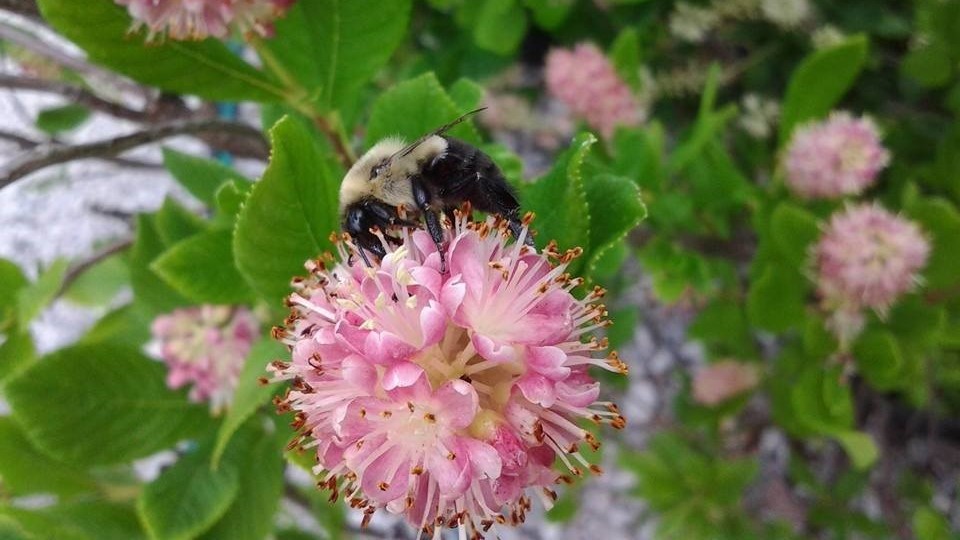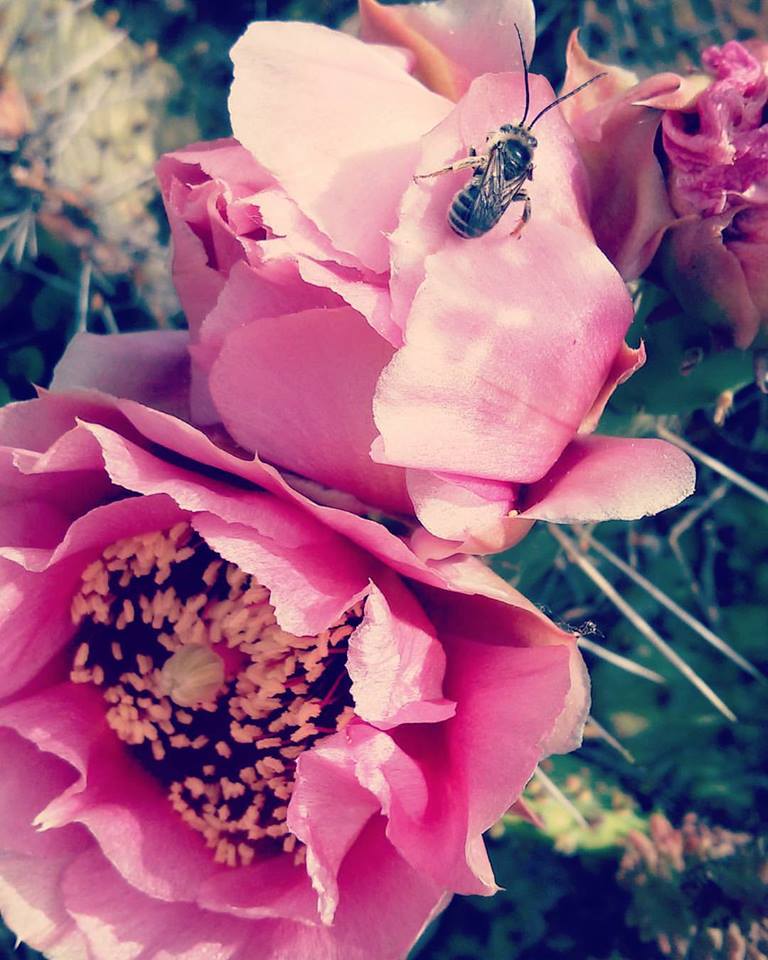
A bee collecting pollen from a Black-eyed Susan (Rudbeckia hirta).
Though it might not seem like it for some of us who are still in the throes of winter and it especially feels like a distant dream as I look outside my window here in Montana, but Spring is right around the corner. Along with this magnificent season filled with new life in our gardens and landscapes our world will soon be buzzing with pollinators as well!
Most gardeners have a basic appreciation for pollinators. We know they are responsible for many things including providing important agricultural and economic services by pollinating many of the crops that we eat and by maintaining the diversity of plant communities (which help feed and house lots of other wildlife who share our space). Although lots of animals are pollinators, including birds, flies, beetles, butterflies, bats, small rodents, and more, bees are the most important of them all! This is because they have branched hairs covering their body which make them extremely efficient at carrying pollen from plant to plant.
Honey bees often get most of the publicity when you think about pollinators, or bees in general. Although they are really important to our agricultural operations they are not native but were brought to North America by colonists in the early 1600s. Some gardeners can even name a few additional types of bees but many may not realize the impressive number of bee species that are native to North America, estimated to be around 4000!
We are also becoming more aware of the fact that many wild and domesticated bees around the world have been undergoing declines over the past few decades of observation- which brings up questions about what we can do to help. The cool thing about this is that we, as gardeners, can have a positive impact on our bees, by thinking about them intentionally as we design and plant our gardens and take care of them throughout the year.
Just like us, bees need a few basic things to survive. They need food, a place to live, and protection from practices that can harm them (such as improper/unnecessary pesticide use). Each of these needs can be an entire blog post of its own, and in fact might be in the coming months, but my goal for this specific post is to introduce you to some of the resources that have regional information for selecting plants for pollinators.

A bumble bee sipping nectar from a ‘Pink Spire’ Summersweet (Clethra alnifolia).
Pollinator Partnership, Xerces Society, National Audubon Society and lots of other educational organizations have a vast array of plant lists available for the pollinator enthusiast (see the resources linked at the end of this post to find an appropriate list of hardy plants adapted to your region). As you select your favorites from these lists there are a few things you should keep in mind to ensure you have the best impact on bees with the plants you select:
- Add a mixture of different colors, textures, and sizes of flowering plants to attract the largest diversity of bees. Some bees (like long-horned bees, leafcutter bees, and honey bees) are generalists, which means that they will forage on a variety of different flowers. Others (like squash bees and sunflower bees) are specialists, which means that they will usually stick to plants in certain families, genera, and even species. By incorporating a diversity of plants in your pollinator garden, you can also accommodate a larger diversity of bee species!
- We know that native plants are an awesome addition to pollinator gardens (because they are well-adapted, and evolved with the native pollinators of the region). That being said, you don’t have to avoid non-native plants altogether. Recent studies show that native and non-native plantings can have a lot of overlap in pollinators. In addition, non-native and native plants will also attract different types of pollinators so you can mix it up!
- Make sure there are flowers throughout the growing season by planting things that will be blooming while bees are continuing to forage. Certain bees are active during certain times of the year when they are collecting pollen and nectar for their nests. Having something flowering throughout the year means that a variety of bees can take advantage of these floral resources. Some of the most critical plants that you can select are those that bloom early and those that continue to flower into the fall as the growing season ends. These early and late season flowers are very important because there are fewer resources available for pollinators during the times that bees are getting started (in the early months of spring) and when certain bee species are getting ready to overwinter in the fall. Having these early and late season flowers means that bees will have a source of food throughout the growing season, not to mention the beautiful blooms that you’ll get to enjoy throughout the year.
- Stay away from plants that don’t have nectar/pollen sources (like some modern hybridized flowers) or those that have complicated features (such as double petals) which make it difficult for bees to actually get to the nectar source.
- Keep these plants safe for pollinators, don’t spray pesticides on plants that are flowering. Or you can wait until the blooms have gone.
Now, you get to enjoy the fun part of choosing plants that are going to add beauty and benefit for pollinators in your yards and gardens.

A bee resting on a Prickly Pear Cactus flower (Opuntia spp.).
Stay tuned for future posts about pollinators and other beneficial insects in the coming months. If you have questions about specific plants, their suitability or pollinators in general, visit the resources below or contact your local Extension Offices for more information.
Resources:
Pollinator Partnership
Planting Guides:
https://www.pollinator.org/guides
Xerces Society Plant Lists:
https://xerces.org/pollinator-conservation/pollinator-friendly-plant-lists
Audubon Society Plant Database:
https://www.audubon.org/native-plants
(Some) Fact Sheets about Gardening for Native Bees:
- https://extension.usu.edu/pdfs/sustainability/files/Gardening-for-Native-Bees-in-Utah-and-Beyond.pdf
- https://www.canr.msu.edu/uploads/236/78920/ProtectPollinatorsInLandscape_FINAL-HigherRes.pdf
- https://extension.colostate.edu/docs/pubs/insect/05615.pdf
- https://njaes.rutgers.edu/fs1280/
- https://www.fs.fed.us/wildflowers/pollinators/gardening.shtml
- https://pubs.extension.wsu.edu/are-native-trees-and-shrubs-better-choices-for-wildlife-in-home-landscapes
- https://ncipmhort.cfans.umn.edu/plant-lists-native-bee-identification-and-videos
- https://beelab.umn.edu/plant-bee-flowers
Seitz, N., vanEngelsdorp, D., & Leonhardt, S. D. (2020). Are native and non‐native pollinator friendly plants equally valuable for native wild bee communities?. Ecology and evolution, 10(23), 12838-12850. https://onlinelibrary.wiley.com/doi/full/10.1002/ece3.6826
I would love to start a new polinator bed where I now have grass. I’m at a loss for the safest or best way to kill the grass and end up with healthy garden soil. Round Up, cardboard, news paper, tilling, ang plastic sheeting all seem to have issues. Can you provide me with a solution.
You can find posts on exactly that topic if you look through our archives. In particular, look for my post on “how to get rid of your lawn” as well as my demonstration on installing a pollinator garden.